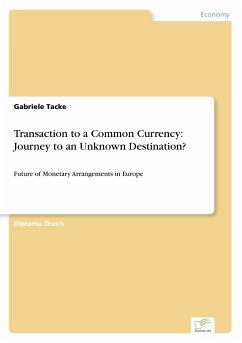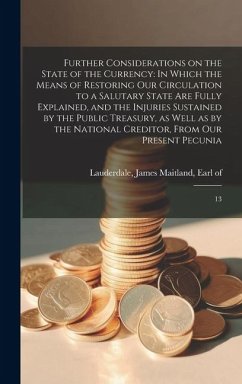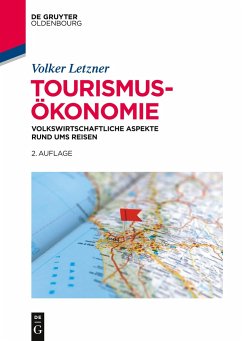
Transaction to a Common Currency: Journey to an Unknown Destination?
Future of Monetary Arrangements in Europe
Versandkostenfrei!
Versandfertig in 1-2 Wochen
38,00 €
inkl. MwSt.

PAYBACK Punkte
0 °P sammeln!
Diploma Thesis from the year 1994 in the subject Economics - Macro-economics, general, grade: 2,0, University of Applied Sciences Münster (Unbekannt), language: English, abstract: Inhaltsangabe:Abstract:"One Market - One Money." On paper the future of European Monetary Integration never looked more promising than now:·The Maastricht Treaty has finally been ratified by all twelve member governments in mid October 1993, even the most sceptical states Denmark and the U.K., so that the aim of European Monetary Union (E.M.U.) rests on a solid legal basis now.·On January 1, 1994 the European Mone...
Diploma Thesis from the year 1994 in the subject Economics - Macro-economics, general, grade: 2,0, University of Applied Sciences Münster (Unbekannt), language: English, abstract: Inhaltsangabe:Abstract:
"One Market - One Money." On paper the future of European Monetary Integration never looked more promising than now:
·The Maastricht Treaty has finally been ratified by all twelve member governments in mid October 1993, even the most sceptical states Denmark and the U.K., so that the aim of European Monetary Union (E.M.U.) rests on a solid legal basis now.
·On January 1, 1994 the European Monetary Institute (E.M.I.) began its operations with a goal of intensifying monetary coordination in Europe.}
In addition, the E.M.I. will prepare the conceptual groundwork for the activities of the future European Central Bank (E.C.B.).
·The " Road to a common Europe" has been opened and monetary policy roadsigns point in the direction of European Monetary Union with a single currency.
In reality, the prospects of the achievement of E.M.U. have deteriorated in the course of 1993 and under present conditions the likelihood of a failure of the Maastricht Treaty is quite high.
The European currency crises in September 1993 led to realignments within the European Monetary System (E.M.S.) and fluctuation margins were widened to +/- 15 per cent. These events and a breakdown of cooperation between national monetary authorities have raised doubts about the feasibility of the timetable for moving towards full monetary union.
This thesis provides an overview of the progress towards a monetary union, including a common currency, in the European Community (E.C.).
In addition, it examines whether the approach to monetary union remains viable and if so, the circumstances under which monetary union will eventually happen.
Inhaltsverzeichnis:Table of Contents:
AcknowledgementsIV
AbbreviationsV
List of Tables and FiguresVI
PART I
1.Introduction1
2.Developments and Purposes to European Honetary Union 4
2.1Definition of a Monetary Union4
2.1.1Background to the current Initiative on European Monetary Union5
2.1.2Why European Monetary Union now?8
2.2Characteristics and Objectives of European Monetary Union10
2.2.1A Single Currency10
2.2.2Free Movement of Capital11
2.2.3Coordination of Macroeconomic Policies12
PART II
3. The Institutional Framework and Transition to a Common Currency12
3.1The Maastricht Treaty - A "Three Stage Approach"12
3.1.1Stage One13
3.1.2Stage Two 13
3.1.2.1Introduction of the European Monetary Institute14
3.1.2.2Characteristics and Tasks of the European Monetary Institute15
3.1.2.3Frankfurt - Home of the European Monetary Institute16
3.1.3Stage Three 17
3.1.3.1Introduction of the European Central Bank18
3.1.3.2Constitution of the European Central Bank 18
3.2Monetary Policy in Stage Three21
3.2.1Convergence Criteria24
3.2.2The Problemof Non-Participation28
3.3Institutional Implications of a Common Currency 31
3.3.1Independence of the Central Bank31
3.3.2Nature of the Transition to a Common Currency34
3.3.2.1The Gradual Currency Approach 35
3.3.2.2The Parallel Currency Approach 36
3.3.2.3The "Monetary-Reform" Approach 38
3.3.2.4 The "Two-Speed" Approach 39
PART III
4.Future Developments in European Banking and Financial Systems,necessary for the Process to European Honetary Union41
4.1Current Trends in European Banking 41
4.2Aims of European Banks in Face of the Internal Market 42
4.3Factors underlying the E.C. Banking Harmonisation Process in Financial Services 43
4.3.1The Second Banking Directive 44
4.3.2Competition and Competitors 45
4.3.3The Centralisation Trend Towards the European Central Bank46
4.3...
"One Market - One Money." On paper the future of European Monetary Integration never looked more promising than now:
·The Maastricht Treaty has finally been ratified by all twelve member governments in mid October 1993, even the most sceptical states Denmark and the U.K., so that the aim of European Monetary Union (E.M.U.) rests on a solid legal basis now.
·On January 1, 1994 the European Monetary Institute (E.M.I.) began its operations with a goal of intensifying monetary coordination in Europe.}
In addition, the E.M.I. will prepare the conceptual groundwork for the activities of the future European Central Bank (E.C.B.).
·The " Road to a common Europe" has been opened and monetary policy roadsigns point in the direction of European Monetary Union with a single currency.
In reality, the prospects of the achievement of E.M.U. have deteriorated in the course of 1993 and under present conditions the likelihood of a failure of the Maastricht Treaty is quite high.
The European currency crises in September 1993 led to realignments within the European Monetary System (E.M.S.) and fluctuation margins were widened to +/- 15 per cent. These events and a breakdown of cooperation between national monetary authorities have raised doubts about the feasibility of the timetable for moving towards full monetary union.
This thesis provides an overview of the progress towards a monetary union, including a common currency, in the European Community (E.C.).
In addition, it examines whether the approach to monetary union remains viable and if so, the circumstances under which monetary union will eventually happen.
Inhaltsverzeichnis:Table of Contents:
AcknowledgementsIV
AbbreviationsV
List of Tables and FiguresVI
PART I
1.Introduction1
2.Developments and Purposes to European Honetary Union 4
2.1Definition of a Monetary Union4
2.1.1Background to the current Initiative on European Monetary Union5
2.1.2Why European Monetary Union now?8
2.2Characteristics and Objectives of European Monetary Union10
2.2.1A Single Currency10
2.2.2Free Movement of Capital11
2.2.3Coordination of Macroeconomic Policies12
PART II
3. The Institutional Framework and Transition to a Common Currency12
3.1The Maastricht Treaty - A "Three Stage Approach"12
3.1.1Stage One13
3.1.2Stage Two 13
3.1.2.1Introduction of the European Monetary Institute14
3.1.2.2Characteristics and Tasks of the European Monetary Institute15
3.1.2.3Frankfurt - Home of the European Monetary Institute16
3.1.3Stage Three 17
3.1.3.1Introduction of the European Central Bank18
3.1.3.2Constitution of the European Central Bank 18
3.2Monetary Policy in Stage Three21
3.2.1Convergence Criteria24
3.2.2The Problemof Non-Participation28
3.3Institutional Implications of a Common Currency 31
3.3.1Independence of the Central Bank31
3.3.2Nature of the Transition to a Common Currency34
3.3.2.1The Gradual Currency Approach 35
3.3.2.2The Parallel Currency Approach 36
3.3.2.3The "Monetary-Reform" Approach 38
3.3.2.4 The "Two-Speed" Approach 39
PART III
4.Future Developments in European Banking and Financial Systems,necessary for the Process to European Honetary Union41
4.1Current Trends in European Banking 41
4.2Aims of European Banks in Face of the Internal Market 42
4.3Factors underlying the E.C. Banking Harmonisation Process in Financial Services 43
4.3.1The Second Banking Directive 44
4.3.2Competition and Competitors 45
4.3.3The Centralisation Trend Towards the European Central Bank46
4.3...














